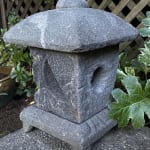-
Artworks












artisan's name unknown
"The Sun and Moon" Yose-Doro Lantern, 14th Century (Lantern Section) ; 17th Century (Top and bottom Section), Contact for PriceStone15" x 15" x 22"SoldFurther images
-
(View a larger image of thumbnail 1
)

-
(View a larger image of thumbnail 2
)

-
(View a larger image of thumbnail 3
)

-
(View a larger image of thumbnail 4
)

-
(View a larger image of thumbnail 5
)

-
(View a larger image of thumbnail 6
)

-
(View a larger image of thumbnail 7
)

-
(View a larger image of thumbnail 8
)

-
(View a larger image of thumbnail 9
)

-
(View a larger image of thumbnail 10
)

-
(View a larger image of thumbnail 11
)

-
(View a larger image of thumbnail 12
)

Stone lanterns were introduced to Japan from Korea with the influx of Buddhism in the 8th century, quickly becoming fixtures of temples and shrines. It was not until around the...Stone lanterns were introduced to Japan from Korea with the influx of Buddhism in the 8th century, quickly becoming fixtures of temples and shrines. It was not until around the 16th century that they began to appear outside of religious settings, making their way into the gardens of tearooms.
Stone lanterns gained popularity in the Edo period (1603-1868) and demand grew for a particular style of lantern found at temples. Dedicated tea connoisseurs would travel to temples hoping to receive lanterns in exchange for generous donations. However, as this practice continued, the supply of lanterns from temples was depleted and collectors had to look elsewhere to satisfy their appetites.
By the Edo period, the earliest lanterns were several centuries old. Over the course of their lives some toppled over, broke, and were worn down by the elements. Their fragmented ruins left untouched to erode and gather moss on gardens surrounding temples. Inventive collectors saw the latent potential of Wabi in these beautifully weathered pieces and began gathering and reassembling disparate parts in a style known as Yose Doro, or “put-together” lantern, a style that came to exemplify lantern aesthetics.
This fine example of a Yose Doro was titled “The Sun and the Moon.” The title comes from the openings of the lantern that have a circle and crescent shape. The light inside shines through as the sun or moon, depending on which side you are looking. This Yose Doro is made of three different parts, which were obtained separately. The middle (lantern) section is from the 14th century, while the top and bottom sections dated from the Edo period. Each section is made of a stone called Kurama-Ishi, Kurama stone. When quarried, these stones are mostly orange-brown, and during years and centuries, the color changes to various grey shades.
Assembling Yose Doro requires the patience, ability, and finesse to find perfect fragments with personalities that harmoniously come together. It is a rare joy when such pieces of different origins and eras are introduced, serendipitously complementing one another.
18of 18 -
(View a larger image of thumbnail 1
)
Signup for our Newsletter
You will receive two emails a month from us. One introduces artworks and design works from Kyoto's hidden sources and the other is stories from Misako, sharing insights into Japanese culture.
* denotes required fields
为了回应您的查询,我们将根据我们的隐私政策处理您提供的个人数据。











